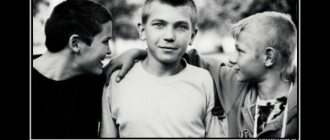Fright and its consequences
The nervous system of young children is not yet mature enough to withstand shocks from the outside world. In situations where an adult can only scream “Oh!”, the baby gets really scared.
The consequences of such a fright are of a different nature - from mild ones that will quickly pass:
- sudden crying, hysteria;
- restless behavior;
- excessive activity;
- numbness.
... to the medium-heavy ones, with whom you will have to fight:
- loss of appetite;
- nightmares, insomnia, waking up in the middle of the night;
- fear of the dark, closed spaces, loud sounds, etc.
... and to severe ones that need to be treated by doctors:
- enuresis;
- neurosis;
- nervous tics;
- stuttering;
- tremor of the limbs;
- anxiety disorder.
Fright
Fright is a reflex reaction to a dangerous or terrible surprise (for example, an unexpected sharp sound, light or other critical stimulus).
The reaction usually includes shuddering, dilation of the pupils, stiffening of the body and retraction of the head into the neck, less often urination, defecation, and a feeling of cold.
Fright and feeling frightened
Fright is often equated with the feeling of fear, but this is wrong. Fear is not a feeling or an emotion, but a purely bodily reflex reaction. The feeling of fear is a change in the entire functional state of a person, body, mind, and soul. A person in a situation of danger may experience reflexive vegetative reactions such as fright (fear), but he will remain internally collected, positive and decisive. On the other hand, a person can live in a constant state of fear (or rather, fear), with a constant feeling of fear, although outwardly, objectively, nothing terrible is happening.
Fright and feeling of fear
Fright should not be confused with the feeling of fear - fear is neither a feeling nor an emotion. It is true that the feeling of fear very often, traditionally follows fright, but often does not mean always and does not mean a natural connection.
He shuddered - it was just fear. He shuddered and came up with a scary picture - closer to fear. Now I put a picture in front of my eyes, I enliven it with my shudder and feel it from the inside as kinesthetics - wow, I’m already afraid! Both fear and the feeling of fear have already been created.
The connection between fear and the feeling of fear is only a connection of habit. Fear can cause a variety of emotions: fear, panic, composure, rage, aggression, and so on, depending on habit and surrounding circumstances.
One, being frightened, triggers fear and panic, another – aggression and rage, the third – calmness and determination. Everyone might have had the initial fear, but others are called heroes.
What affects the strength of fear?
The strength of fear is affected by:
- The unexpectedness of what happened. The more unexpected the incident, the stronger the feeling of fear. From the slam of a door or a sharp explosion of a balloon, just a slight shudder occurs, from more terrible stimuli - freezing, a feeling of cold, and so on.
- Previous negative experience. If before this there is some unpleasant memory associated with what happened, the fear will be stronger, and it will arise even with a hint of a terrible situation. It happens that a horse, having fallen heavily during a jump, is then afraid to even enter territory similar to the one where it fell.
- Current emotional background: if a person is tense, worried, nervous, fear can manifest itself in the slightest influence of the surrounding world. Dark night, deserted street, and suddenly the door of the back entrance creaked... - Horror! Or a sunny morning, there are a lot of people, the entrance door creaks... - Just think...
- Repeated exposure with the ability to make sure that the fear is not terrible: then addiction occurs and the fear goes away. Once they clapped their hands in front of your face, you involuntarily blinked. Two slammed - you blinked. Three slams - and you are no longer afraid, you’re used to it and don’t blink...
The evolution of fright
Fear is one of the most ancient reactions of all living beings, along with pain and aggression. In the animal world, fear is needed to protect oneself from external factors. If pain saved the animal from internal injuries, then fear, pain and aggression saved it from external injuries.
Primitive animals need fear in order to somehow protect themselves from troubles from the outside world; the reaction to fear is basically to run away, swim away, crawl away from the frightened object.
The further the species evolved, the more complex the reaction to fear became. In general and in general, the reaction to fear in the mammalian animal kingdom includes four stages:
Run away! as fast as possible.
In this case, the horse takes the rider anywhere, as long as away from this place. There have been cases where, frightened, horses ran away so stupidly that they crashed into trees standing in their way.
If it is impossible to escape - Fight!
Everyone knows that a wild animal driven into a corner is more dangerous than any other.
If you don’t have enough strength to fight, freeze in a stupor, become numb.
The goal is to stun the enemy, to fake your death - what if he falls behind?
If this doesn’t help, lose consciousness.
Because it’s too scary to think further.
Fear here is only a triggering moment; everything else happens without a head, simply on instinct. Some species may not have all stages, and some may be excluded. The easiest way to test this chain is on horses - they have it developed to perfection.
However, evolution did not stop at the animal world and moved on. People, unlike their smaller brothers, know how to turn on their heads when scared.
Another thing is that they don’t always use it.
At the moment after a fright, a person always has a choice - what to do next. And many people know how and are accustomed to responding to a feeling of fright not with fear, but with composure, energy, calmness, and determination. However, there are those who still prefer to react differently.
Thank God people can't run so fast that they crash into a tree.
How to cope with fear
It is extremely difficult, almost impossible, to cancel your reflex reactions. But it’s possible to learn to use determination rather than fear. How to do this - see Working with fear.
Causes of fear
Because of differences in life experiences, adults and children are afraid of different things. For example, if for us the squeal of brakes is a harbinger of an accident, then for a child it is only a loud sound. In such a situation, an adult will tense up, look around, and try to go to a safe place. And the baby will show maximum curiosity and look towards the source of the sound.
At the same time, children can be frightened by completely trivial things. For example, a dove flying overhead or a clown at a party.
What else can scare a child:
- Loud sounds that arose abruptly: a hammer drill, a scream, the roar of thunder, a dog barking.
- Scary pictures, exotic animals, people with unusual appearance.
- Doctors and medical procedures if the child has a negative experience.
- Stressful situations: moving, separation from parents.
- Emergency incidents: animal bite, falling from a slide or bicycle, physical violence.
Why do we freeze in fear?
Almost all living creatures - from flies and fish to people - freeze in fear when they feel threatened. So, a deer freezes on the road, blinded by the headlights of an approaching car. The fly, having caught dangerous vibrations, loses its normal mobility. This seems not entirely logical from a biological point of view: after all, if you feel danger, run! But no. Even a person falls into a state of stupor out of fear, which often prevents people from quickly leaving a disaster zone or the site of a terrorist attack.
This mysterious phenomenon was recently clarified by scientists from Columbia's Zuckerman Institute. They studied the freezing response in response to a potential threat in the fruit fly Drosophila.
It turned out that the reaction of instant numbness of the body is caused by serotonin. This bioactive chemical is considered the "feel good" or "happy hormone" but is also involved in our fear response. It is generally responsible for regulating mood and emotions.
“Imagine sitting in your living room with your family and suddenly the lights go out or the ground starts shaking,” said study leader Richard Mann. “Your reaction and your family's reaction will be the same: you will stop, freeze and then move to a safe place. With this study, we show in flies that the rapid release of the chemical serotonin in the nervous system leads to this initial freezing. And since serotonin also exists in humans, this discovery sheds light on the nature of human fear."
Previous studies in flies and vertebrates have shown that serotonin also affects the speed of movement of animals. Colombian scientists were able to confirm this fact and even shoot a video that allows you to compare the speed of regular flies and those “paralyzed” by serotonin: these are 25 mm/s and 15 mm/s, respectively. The resulting image is accelerated five times.
Current
- An implant was grown from fat cells from the abdomen to heal paralyzed people
- Scientists have found a new reliable way to make rain
- Just 3 seconds of exercise a day makes biceps 10% stronger - study
In this experiment, the scientists did not scare the flies, but directly manipulated the levels of serotonin in their nervous system. As soon as they activated the neurons that produce serotonin, the fly slowed down, and as soon as they suppressed the production of the substance, it accelerated. The relationship was also observed under different experimental conditions: when the temperature changed, the flies were hungry or walked upside down on the surface.
The greatest fading effect occurred with the fastest environmental changes. In one experiment, the researchers created pitch darkness, in another they simulated an earthquake. In both cases, the flies' serotonin levels rose sharply and they became numb. There was a pause in walking, after which the insects moved again: in the first case slowly, in the second - quickly.
“We believe this pause is important. It allows the fly's nervous system to gather information about the sudden change and decide how to respond,” says study co-author Claire Howard. According to scientists, in case of fear, serotonin acts as an “emergency brake” in the same way in both flies and humans.
How does the child feel?
Immediately after a strong fright, the baby is stressed. His natural impulse is to snuggle up to his mother as quickly as possible or go home to a comfortable environment. After a fright, some children sleep for a long time and soundly - this is how the nervous system recovers from a sudden overload.
It is very important in the first minutes after a fright to calm down, hug the baby, and talk to him in a quiet, gentle voice. Now he is in dire need of maternal warmth and tranquility.
The consequences of fright may not appear immediately. Even if the baby stopped crying and returned to play, this does not mean that everything is in the past. The fact is that the emotional background of children under 5 years of age is so unstable that memories of fear can themselves cause severe stress. This is how fears, phobias, and neuroses are formed, which sometimes last for years.
How do parents feel?
The first emotion that a mother of a frightened child encounters is confusion. In the first seconds, it may be difficult for her to navigate and determine the so-called “amount of damage.” Therefore, in such a situation, one can understand the child’s confusion or delayed reaction to the source of stress.
After a minute, the understanding comes that the baby was very scared. And here it is important to behave correctly:
- try to calm the child down with words;
- support tactilely - hug, caress, kiss;
- switch his attention to something neutral (give him a toy);
- leave the place where it happened;
- monitor the condition of the baby at home;
- be prepared for the consequences of fright.
Not all parents realize the degree of influence of stress on the child’s psyche. Therefore, some may deny the presence of fear, while others may associate any disturbances in the child’s behavior or well-being with it. Still, it’s better to stick to the golden mean: don’t ignore what happened, but don’t attribute all the problems to fear.
Also important:
- do not shout at a frightened child;
- do not shame him, do not force him to calm down;
- do not engage in active games immediately after a stressful situation.









